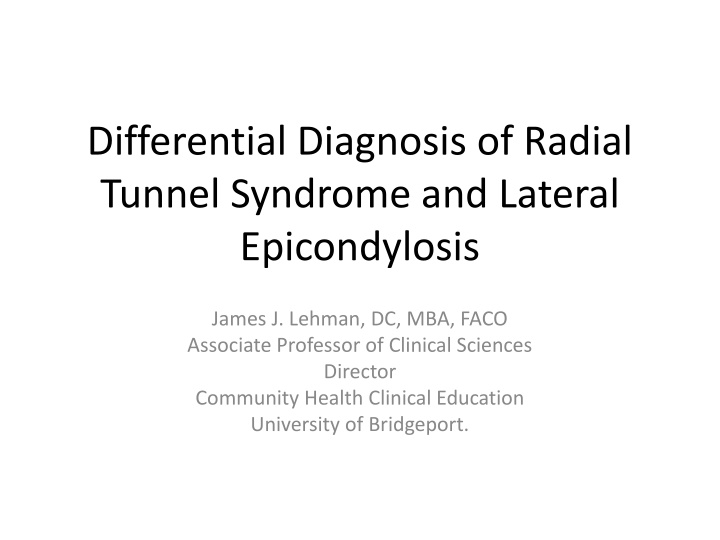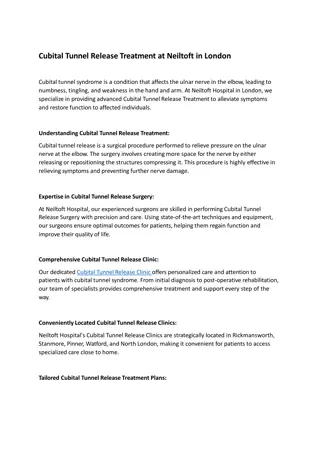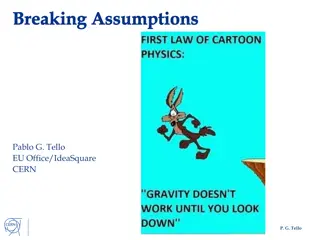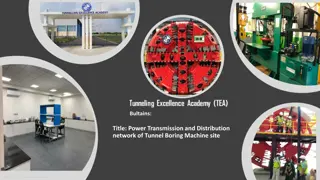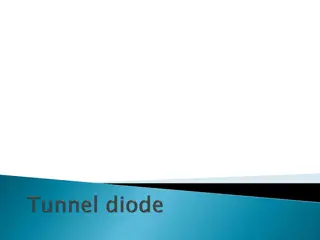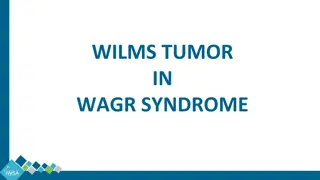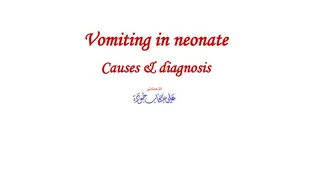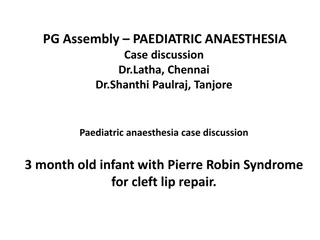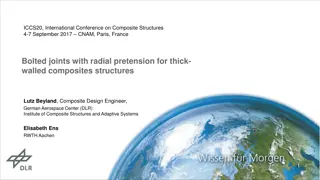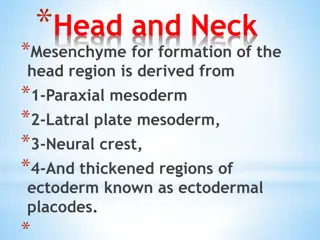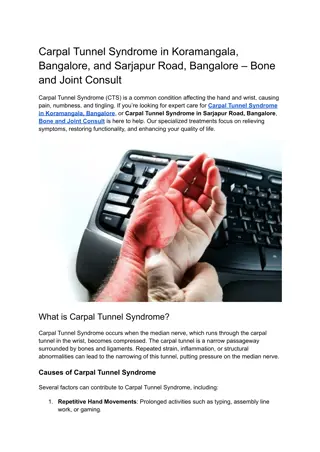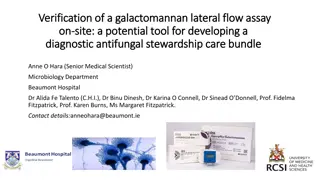Radial Tunnel Syndrome and Lateral Epicondylosis: A Differential Diagnosis
Explore the differential diagnosis of radial tunnel syndrome and lateral epicondylosis as discussed by James J. Lehman, DC, MBA, FACO, focusing on anatomy, signs, symptoms, and evaluation procedures.
Download Presentation

Please find below an Image/Link to download the presentation.
The content on the website is provided AS IS for your information and personal use only. It may not be sold, licensed, or shared on other websites without obtaining consent from the author.If you encounter any issues during the download, it is possible that the publisher has removed the file from their server.
You are allowed to download the files provided on this website for personal or commercial use, subject to the condition that they are used lawfully. All files are the property of their respective owners.
The content on the website is provided AS IS for your information and personal use only. It may not be sold, licensed, or shared on other websites without obtaining consent from the author.
E N D
Presentation Transcript
Differential Diagnosis of Radial Tunnel Syndrome and Lateral Epicondylosis James J. Lehman, DC, MBA, FACO Associate Professor of Clinical Sciences Director Community Health Clinical Education University of Bridgeport.
Learning Objectives Correlate anatomy and the patients signs and symptoms in order to locate the neuromusculoskeletal lesion(s) and properly record the findings.
Learning Objectives Identify injured and painful tissues through careful assessment and intelligent use of neuromusculoskeletal testing and document the findings.
Learning Objectives Perform neuromusculoskeletal evaluation procedures (Posture, orthopedic and neurological) and record the objective findings in order to make an assessment/diagnosis.
The radial nerve is formed from the posterior cord of the brachial plexus, with contributions from C6, C7, C8, and T1.
The nerve passes between the medial and lateral heads of the triceps muscle, continuing distally along the lateral side of the arm.
Approximately 10 cm above the elbow, the radial nerve pierces the lateral intermuscular septum and continues distally between the brachialis and brachioradialis muscles
Just proximal to the radiocapitellar joint, the radial nerve bifurcates into the superficial radial nerve and deep radial nerve (posterior interosseous nerve)
The superficial branch of radial nerve is a sensory branch, and innervates the skin of the thumb, index, and middle fingers.
The posterior interosseous nerve is a motor branch, and supplies the wrist and finger extensors. This branch passes through the supinator muscle between its superficial and deep heads, exiting into the posterior compartment of the forearm.
Nerve damage The effects of compression on peripheral nerves can be attributed to alterations of blood circulation to and from the nerve as well as direct injury to the axonal transport systems.
Venous blood flow from the peripheral nerves is shown to be reduced at 20 to 30 mm Hg, whereas frank ischemia can occur at pressures of 60 to 80 mm Hg.
Neuropraxia The mildest grade is called neuropraxia, a reduction or complete block of conduction across a segment of a nerve with axonal continuity conserved.
Neuropraxia More specifically, it is dysfunction and/or paralysis without loss of nerve sheath continuity and peripheral Wallerian degeneration Nerve conduction is preserved both proximal and distal to the lesion but not across the lesion.
Neuropraxia Conduction block, focal demyelination at edges of nodes of Ranvier or complete internode segments. No axonal abnormality; therefore, no Tinel s sign. Full recovery with repair of conduction block or remyelination.
Neuropraxia A person's foot "falling asleep" after her legs have been crossed is an example of a functional loss without abnormal change.
Axonotmesis Axonotmesis is a more severe grade of nerve injury compared to neurapraxia.
Axonotmesis is a result of damage to the axons with preservation of the neural connective tissue sheath (endoneurium), epineurium, Schwann cell tubes, and other supporting structures..
Wallerian degeneration A compression neuropathy may begin as a mild injury to epineural vessels under mild pressure. The subsequent edema can lead to fibrosis, which increases further pressure on the nerve, leading to a progressive deterioration of the nerve. Rydevik B, Lundborg G. Permeability of intraneural microvessels and perineurium following acute, graded experimental nerve compression. Scand J Plast Reconstr Surg 1977;11:179 187.
Axonotmesis Thus, the internal architecture is relatively preserved. This can guide proximal axonal regeneration to reinnervate distal target organs. Distal Wallerian degeneration occurs in axonotmesis.
THE TERM Saturday night palsy has become synonymous with radial nerve compression in the arm resulting from direct pressure against a firm object. It typically follows deep sleep on the arm, often after alcohol intoxication. Spinner RJ, Poliakoff MB, Tiel RL.The origin of "Saturday night palsy? Neurosurgery. 2002 Sep;51(3):737-41; discussion 741.
Neurotmesis is the most severe grade of peripheral nerve injury. It occurs when the axon, myelin, and connective tissue components are damaged and disrupted or transected.
Radial Tunnel The radial tunnel is a potential space 3 to 4 finger breadths long, lying along the anterior aspect of the proximal radius
The radial nerve begins as the terminal branch of the posterior cord of the brachial plexus. The nerve begins posterior to the axillary artery and travels through the triangular interval and then continues along the spiral groove of the humerus.
The radial nerve continues to travel distally and ultimately bifurcates into deep (PIN) and superficial (SBRN) branches approximately 6.0 to 10.5 cm distal to the lateral intermuscular septum and 3 to 4 cm proximal to the leading edge of the supinator.
The PIN is a motor nerve that courses deep beneath the supinator muscle; the SBRN is a sensory nerve that travels anteriorly on the undersurface of the brachioradialis and, in the distal one-third of the forearm, travels subcutaneously to provide sensation to the dorsoradial hand.
History Pain along the dorsoradial aspect of the proximal forearm, which radiates proximally and distally. Rotational activities of the forearm increase the severity of the pain. Muscle weakness may present due to pain (SBRN) or denervation (PIN). Deep throbbing pain at night post aggravation.
Risk Factors Regular use of force of at least 1 kg for more that 10 repetitions per hour with the elbow constantly extended between 0 degrees and 45 degrees with frequent pronation and supination of the forearm would increase the chance of developing radial tunnel syndrome. Roquelaure Y, Raimbeau G, Saint-Cast Y, et al. Occupational risk factors for radial tunnel syndrome in factory workers. Chir Main 2003;22:293-8.
Physical Examination Localized focal tenderness over the anatomical landmark, approximately 3-5 cm distal to the lateral epicondyle over the supinator mass (Loh and Rule of Nine ). Cozen s test is usually negative for pain but active forearm supination or extension of middle finger with resistance produces pain at radial tunnel.
Lateral Epicondylitis/Epicondylosis/tendinopathy Tennis Elbow Test or Cozen s test
Resisted extension of middle finger will produce pain at the radial tunnel
Definition of an orthopedic test Most often, a provocative maneuver that reproduces the patient s chief concern pain by stretching, compressing and/or contracting of tissues in order to identify the involved tissues. James J. Lehman, DC, FACO
Spine Evaluation 1. History 2. Observation 3. Palpation 4. Range of motion 5. Special tests or Orthopedic tests 6. Imaging and other tests
Imaging and Neurodiagnostics Routine radiographic examination is nondiagnostic but MRI might demonstrate denervation edema or atrophy within the supinator or extensor muscles. Absence of standardized electrodiagnostic findings on both nerve-conduction velocity and EMG
Differential Diagnoses Lateral epicondylosis Posterior interosseous nerve syndrome (Deep branch of the radial nerve) motor nerve Radial tunnel syndrome (Superficial branch of the radial nerve) sensory nerve Ulnar neuropathy
Treatment Conservative care should precede surgical intervention Wrist splinting Activity modification NSAIDS Avoid activities or treatments that increase the symptoms
Relative Contraindication Mills maneuver of the elbow to release adhesions of the capsule and periarticular soft tissues.
Absolute Contraindications Soft tissue treatments (Instrument assisted, deep friction massage, and stretching) Heat/Ultrasound Tennis elbow brace Repetitive strain activities such as progressive resistive exercises, walking dog, use of laptop and tools that require pronation of forearm
Active Learning Task Form a learning group of four doctors Select a spokesperson Using a SOAP format, create a putative case and chart the subjective and objective findings, assessment, and plan of a patient suffering with a radial tunnel syndrome involving the superficial branch of the radial nerve (sensory nerve).
Active Learning Task You will have 30 minutes to create and chart the putative case The spokesperson will have 5 minutes to present your case to the audience Audience will critique the presentation Five groups will present
Recommended Reading Unusual Compression Neuropathies of the Forearm, Part I: Radial Nerve Alan C. Dang, MD, Craig M. Rodner, MD J Hand Surg Am. 2009 Dec;34(10):1906-14. http://nemsi.uchc.edu/clinical_services/orthopa edic/handwrist/pdfs/article_radialnerve.pdf
References Rydevik B, Lundborg G. Permeability of intraneural microvessels and perineurium following acute, graded experimental nerve compression. Scand J Plast Reconstr Surg 1977;11:179 187. Spinner RJ, Poliakoff MB, Tiel RL.The origin of "Saturday night palsy? Neurosurgery. 2002 Sep;51(3):737-41; discussion 741. Roquelaure Y, Raimbeau G, Saint-Cast Y, et al. Occupational risk factors for radial tunnel syndrome in factory workers. Chir Main 2003;22:293-8. Dang AC & Craig M. Rodner CM. Unusual Compression Neuropathies of the Forearm, Part I: Radial Nerve. J Hand Surg Am. 2009 Dec; 34(10):1906- 14. Available from: http://nemsi.uchc.edu/clinical_services/orthopaedic/handwrist/pdfs/artic le_radialnerve.pdf
